I recently received a copy of the LEGO Life magazine (December 2014 – NO. 4 issue), which is an internal publication for employees of The LEGO Group. It has some really interesting articles, and I thought to share some of them with you. You can read a couple of previous articles from the magazine here: 2015 LEGO Star Wars New Life to the Galaxy. Another article I found very interesting was on the history of LEGO minifigures. It is titled “Ancestor of All Minifigures” written by Bo Byskov-Eriksen with photos by Niels Age Skovbo. You can read the article below. 🙂

ANCESTORS OF ALL MINIFIGURES – There would be no minifigures if it wasn’t for a few resourceful LEGO employees – 40 years ago – taking the initiative in creating the LEGO construction figure.
It is probably difficult for most people today to imagine a LEGO set without minifigures as a natural part of the play scene. But until as late as 1974 children had to mange without the now-familiar minifigs. In the 1960s and 1970s most LEGO building activity consisted of houses, trains and cars – and if “people” were needed, children had to create them. To give children more options in their creative play, in 1969 the LEGO Group worked on the idea of creating “people” for the LEGO universe. And company designers were asked for their suggestions for a LEGO figure.
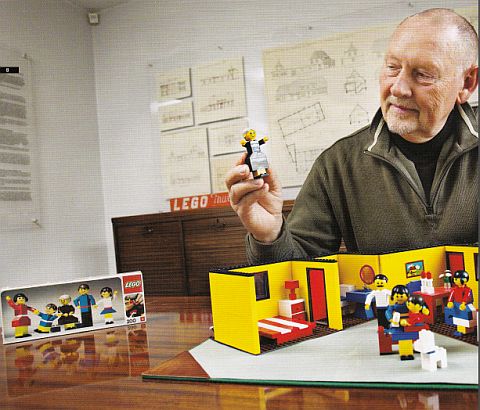
The static figure – One of those designers was Jan Ryaa. “In 1971”, says Jan Ryaa, “we were producing sets for girls – doll houses with furniture but no people. Role play in those days was very much dad-mom-children, so a play figure was important. We got to work on it, but I seem to recall we had a few problems getting the arms to work properly.” Today, Jan Ryaa is a senior platform specialist with Design Lab and has worked with the LEGO Group for more than 40 years.
The designers’ various suggestions were tested on children in the 4-7 age group, and one of the ideas (a figure with movable legs) was dropped because tests showed it was too difficult for children both to build and play with the figure. Jan Ryaa: “We worked and experimented with several moving joints on the figure. We tried unsuccessfully with jointed hips and legs – and finally ended up with a figure built entirely of ordinary LEGO bricks.”
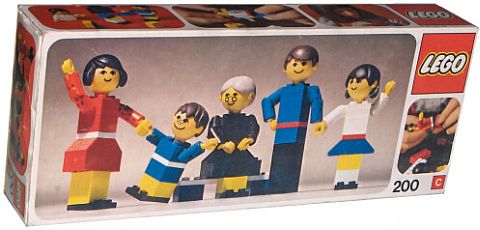
Welcome to the LEGO family – The designers produces a figure which had a torso and legs built from ordinary LEGO bricks but had a few new elements; a yellow, round head and an element complete with arms and hands.
In 1973 the designers and the LEGO Group revisited the problem, discussing the appearance of the figure. After lots of talk across the design desk about skin color and facial expression the decision was: a yellow head with black facial markings. “We spent ages decorating those figures, and as was the custom in those days we got help from external partners in arriving at the finished figure”, says Jan Ryaa.
After what had been several years of development, the figures made their debut in 1974, joining the LEGO range as product set #200, a family group consisting of grandmother, father, mother and two children. The family members had movable arms, brick torso, and hair elements which could be swapped around. The set was an instant hit with shoppers, and established new standards for production.
“Having decided to make the figures, we then had to improve our in-house skills for decorating them. Consequently, we invested in our first decorating machines – and introduced weekend production”, recalls Jan Ryaa. The success of set #200 was recognized by a Toy of the Year award in Britain that same year.
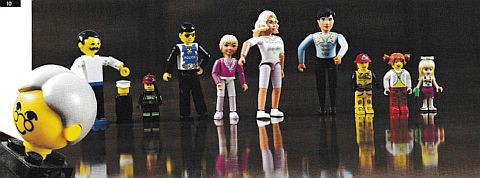
Fine-tuning the figure – However, the figure had one major problem: it was too large in relation to the rest of the building set. So it was back to the drawing board, creating a new figure more in proportion to the rest of the range. When complete, it had a shiny yellow head, a torso with the contours of arms, and a single solid leg. Its in-house nickname was “The Extra”.
In 1975, LEGO Group Owner Godtfred Kirk Christiansen (father of the present owner, Kjeld Kirk) worked intensely with the development team in creating a more suitable figure. Jan Ryaa: “The aim was to create a figure which matched the general LEGO environment – and development work became a day-and-night effort. There were people with saws and files working on the original, stiff-legged miniature.”
Four years after the construction figure was invented, and after many prototypes, the little character with moving arms and legs – with hands which could hold objects and a smiling face and eyes was ready in 1978. The minifigure was born.
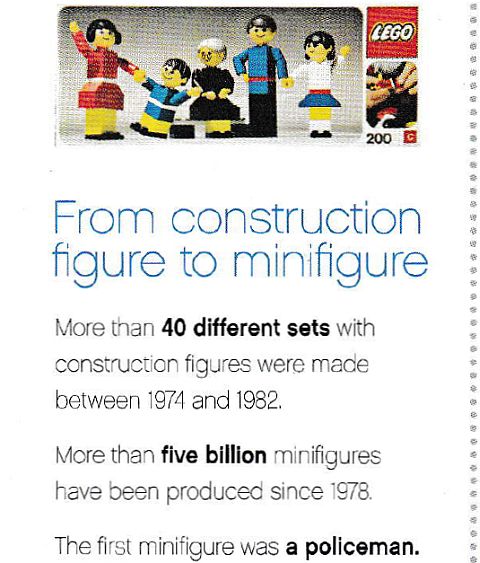
Construction figure retires – The construction figure continued for a few more happy years – but in 1980 it retired from active duty, not to be used in new products. But the arms and hands were used for new functions for some years beyond that.
When LEGO Technic registered its success, a figure on the same scale was produced. It had movable arms and legs. And later, product developers created some figures for girls. They were designed to be more natural with the intention of encouraging girls to engage in LEGO building – for example, LEGO Belville and the Scala universes.
“Minifigures became popular as soon as they arrived on the scene – so much so that interest in the construction figure declined completely. But in a way the 1974 construction figure and grandmother were the ancestors of the minifigure – and the rest is history,” says Jan Ryaa.
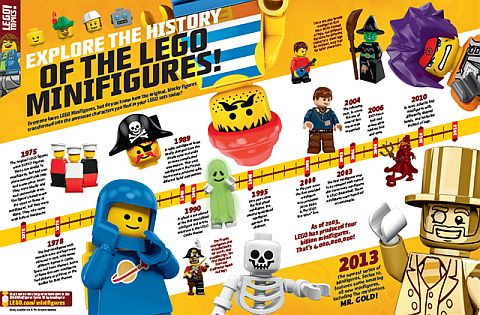
Interesting, isn’t it? I think this article is particularly significant in light of the still ongoing (although much quieter) debate about the LEGO Friends and LEGO Disney Princess mini-dolls. Some people feel resentful that the mini-dolls are different than regular LEGO minifigures. However if we put the mini-dolls in historical perspective we will see that LEGO has always experimented with different types of characters. Yes, the minifigure has been the most successful and well known in recent times, however this doesn’t mean that LEGO stopped creating different figures for different themes and product lines.
LEGO Technic had its own larger figures that fit into Technic vehicles better. LEGO Juniors also had larger figures made for younger children. The LEGO Hero Factory and LEGO Bionicle lines have their own entirely different figures built with ball-joint elements and clip-on armor-plates. And don’t forget about the adorable and now highly collectible LEGO Fabuland characters. Also, two previous LEGO themes aimed at girls had their own special line of figures as mentioned in the article: LEGO Scala (1997-2001) and LEGO Belville (1994-2008). In addition, LEGOLAND parks have figures in LEGO MiniLand scale, which are the closest to the original brick-built characters. Interestingly, hardly anyone ever complain about any of them.
While LEGO minifigs are very popular and most people like them and even collect them, I think it’s important that we don’t try to force a highly creative company like LEGO into one scale and one type of figure design only. We know that LEGO vigorously tests their new products with children and take kids’ feedback very seriously. It was the children (specifically young girls who previously were not interested in LEGO) who choose the mini-dolls, over regular minifigs, so let them have their own characters. Their existence in no way threatens regular minifigs, and girls who prefer minifigs over mini-dolls continue to have plenty of choices as well.
So I would say let LEGO pursue testing, creating, inventing, and offering a range of products that many different people can enjoy. After all the world of LEGO is a miniature reflection of our own, and in reality there are people of different sizes, colors and shapes. LEGO is already quite uniform with making sure that everything fits into their well-defined and time-tested system. A little diversity will only add more options and flavor to it. LEGO Friends and LEGO Disney Princess have been a huge hit, so obviously the careful testing, and meticulous design process paid off yet again – just like in the past…

What do you think? How did you like the article on the history of LEGO minifigures? Did you learn something you didn’t know before? Do you have any of the original brick-built LEGO figures? Are there any LEGO characters that you really like that are non-standard minifigs? Feel free to share your thoughts and discuss in the comment section below! 😉
And you might also like to check out the following related posts:
- LEGO Star Wars New Life to the Galaxy
- An Ideal Book for LEGO Minifig Collectors!
- LEGO Friends – LEGO’s Billion Dollar Girl
- The LEGO Inside Tour – Introduction
- Wishing Happy 80th Birthday to LEGO!
- How Much Do You Know About LEGO?
- Unofficial LEGO Collector’s Guide Available!
- LEGO Book: Brick by Brick Review
- CNN News: Everything is Awesome for LEGO












I think this article fails to mention the “proto-minifig” from 1975, they were on the same scale as current minifigs but lacked any prints or movable parts. You could see some examples on the right side of the images. When the modern minifig first arrived in 1978, there were several sets where it was included with a non-compatible car, and such, Even more curiously, it was included in several “maxifig” sets as as baby. It carries some unfortunate implications for the modern Lego world…
Sorry, that must be left side, unless you surf by looking at your screen from behind…
Hakan, here the focus is on the original figure, but Jan does mention the solid minifig you are referring to as well. It’s in the article, right below the picture you mentioned: So it was back to the drawing board, creating a new figure more in proportion to the rest of the range. When complete, it had a shiny yellow head, a torso with the contours of arms, and a single solid leg. Its in-house nickname was “The Extra”. 🙂
I found a higher resolution of that timeline image. There they’re referred to as “Duplo figures”. It seems the writer made an error. Short deadlines…
My daughter and I both love the mini-dolls and collect Friends (and some of the Disney) sets. It was this line, with the mini-dolls, that started us collecting Lego. I am so thankful to Lego for creating these wonderful sets (with beautiful, happy faces and colors), and I hope they continue to do so!
Agatha, LEGO Friends and Disney Princess are definitely here to stay. Also, LEGO Elves are coming out shorty, and I think you will like those as well, as they are also very sweet. 🙂
Very interesting. I’ve never bothered much about the minifigs’ history, when I got into LEGO they were the main type of figure, so they’ve always been around for me. Since LEGO redid their building figure so many times, maybe they’ll redesign the minifigure to have ball-socket shoulders, to give more mobility. It’d be like mini-Mixel ball joints, you could remove the arms and everything. The only problem is that there are so many problems to that. I can instantly think of at least three. 🙁 😕
Also: http://brickset.com/article/13961/london-toy-fair-report-part-2 I agree, the non-licensed themes are taking the lead this year, which I find to be a good turn. But there is Speed Champions, which, despite the stickers, looks pretty good. 🙂
Lastly, I noticed that the availability markers for the sets on LEGO Shop have been updated. They look to be in bold, and represented by different colors. I think I liked the old version better. 😐
I think LEGO minifigs are here to stay for good with no major changes. They are too established, too popular, and LEGO fans would be outraged if minifigs would change. However it is likely that LEGO will continue experimenting with other character designs in specific themes. I think that’s a good compromise. This allows them to continue trying out new ideas without disturbing the core market. Personally I love both regular minifigs and mini-dolls. They can coexist peacefully in my LEGO world, just like flesh-colored and yellow faced minifigs can. And I also collect Fabuland animals and Hero Factory mini heroes. They fit right in too. 🙂
An interesting read, I think they did a good job with the final result: our modern friends we have here! 🙂
Wow, I didn’t know that they were that old! We have that set in the second picture! I think we got it in a garage sale. We also have two of the ones all the way on the right in the third picture.
I like it that LEGO has two different types of minifigs, it shows LEGO’s creativity still remains! (not that it doesn’t.) they’ve also made LEGO minifig arms that are out (LEGO monster fighters: bat, LEGO DC: manbat.)
I find it hard to believe that no one complains about Miniland figure scale. I find it obnoxious and upsetting to be honest, and that’s the one takeaway I had from LegoLand California- would have been so much better if everything had been built in mini-fig scale.
William, the MiniLand scale figures are actually an established standard many LEGO fans and LEGO designers use for larger models. They also represent a good deal of LEGO history. Although for those who joined the hobby later and are only familiar with minifigures they could look a bit strange, but they in fact represent another very important scale; the scale of the brick-built figure.
A lot of older LEGO fans say that minifigs actually ruined LEGO because since they have become so prevalent most people end up being building in a scale suitable for minifigs, thus significantly limiting the hobby. Previous to their appearance LEGO fans built in many different scales. There are of course still those who build in different scales including micro-scale and MiniLand scale. There are also a good number of official LEGO sets that are not built for minifigs scale. These usually include display-models like the VW Camper, MINI Cooper, LEGO Architecture sets, etc. Also, brick built figures are still very popular with LEGO fans. The Cube Dude craze is one example from recent years. Everybody was building Cube Dudes! 😛
While minifigures are here to stay and most LEGO sets will follow a scale that is suitable for them, LEGO is far more than just elements to build homes for minifigs. It is a good ideas to at least sometimes step out of that scale and build either larger or smaller. Also, experimenting with brick-built figures is a good challenge and an excellent way to refine your building skills. 🙂
I just read your article on cube dudes, they look pretty cool. I like minifigures because they give me me something to check my scale against.
I have a couple of the Technic figures in a box, they are not mint because I snatched them form my uncle in the 90s lol
There’s been some recent fervor in some corners of the web, some webcomic cartoonist drew up a comic complaining about Lego Friends for being Legos for girls rather than encouraging girls to play with “normal” Lego sets. (The specific example was “You could have put female astronauts into Galaxy Squad and gotten the same result as developing the entire Friends theme.”) Because girls having toys tailored to their interests is how the male agenda keeps women down, you see. Then some ultra-feminist who’d written a book on that sort of topic wrote a blog post interviewing the cartoonist.
I didn’t know about the test marketing for the minidolls you described, although, of course there was. And Friends has obviously been a success, so clearly the target audience is having their needs met, despite not knowing they are supposedly letting their gender down by doing so.
Years ago I bought a little Technic forklift pretty much entirely because I wanted the Technic figure it came with. Those dudes were cool.
I found the webcomic here.
http://seasonaldepressioncomic.com/2014/12/06/lego-friends/
Rather interesting discussion following in the comments below.
Yeah, LOL! Grown-ups are so confused! 🙄
And here’s an interview, although I’m not sure if that’s the same one mentioned in the post.
http://rebeccahains.com/2014/12/23/lego-friends-comic-goes-viral-an-interview-with-illustrator-maritsa-patrinos/
Yeah, that’s the one. There’s a comment somewhere in there from me pointing out that Galaxy Squad does have a female character, and there’s no hair as depicted in the comic since they are all wearing space helmets.
Yeah, saw that comic a few weeks ago. The ironic part is that LEGO Galaxy Squad has one of the awesomest female astronauts! 😛
Completely agree with you admin. Ashlee Starstrider is the best female astronaut, but sadly I think she is one of the only female astronauts. Not that you could tell during classic Space… everyone looked the same then. 😕 😉
Yeah, Classic Space has very homogeneous minifigs. And even though they just have a generic smile I always considered them guys. Actually, now that I think about it, it never even occurred to me that they could be girls. They have that goofy grin only guys would have. 😛
Looks awesome! XD haven’t been on this website for a long time D: I’ve missed all the articles!
Chris, nice to have you back! There has been so much to talk about! Looks like LEGO is continuing to have a very strong year. 🙂
I have a set with one of those giant firemen and a girl!